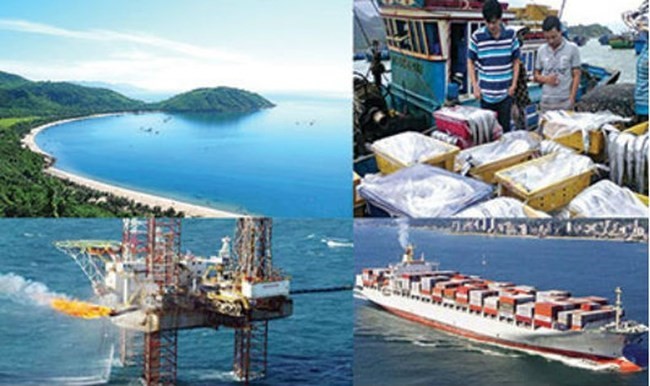(VOVWORLD) - Vietnam, a coastal country on the East Sea, has a marine index 6 times higher than the global average. With 28 coastal provinces and cities accounting for 42% of its land area and 45% of its total population, Vietnam has the great advantage of marine and island resources. Resolution 36 on "Strategy for sustainable development of Vietnam's marine economy to 2030, with a vision to 2045", adopted at the 8th Plenum of the 12th Party Central Committee, outlines the importance of developing the sea and island economy and making Vietnam a strong, rich maritime country.
 Party Resolution 36 paves the way for Vietnam’s marine economy’s development Party Resolution 36 paves the way for Vietnam’s marine economy’s development |
Vietnam has a coastline of 3,260 kilometers aligned north and south, with a ratio of approximately 100 square kilometers of land per kilometer of coastline. The world average is 600 square kilometers of land per kilometer of coastline.
With more than 3,000 islands, including the Hoang Sa (Paracel) and Truong Sa (Spratly) archipelagos, the seas and continental shelves under Vietnam's sovereignty, sovereign right, and jurisdiction cover more than 1 million square kilometers, three times larger than the land area.
Diverse potential for marine economic development
Vietnam's sea contains reserves of 35 minerals in addition to oil and gas. In 2022 Vietnam's crude oil production was nearly 11 million tons. In Vietnam’s waters, some 11,000 species of living organisms have been discovered in 20 different ecosystem types in 6 different marine biodiversity regions. Some 1,300 species have been discovered on Vietnam’s islands.
Marine ecosystems provide enormous resources for the economy. Last year Vietnam’s total fishing production was more than 9 million tonnes. In the first half of this year it totaled 4.27 million tons.
Associate Professor Dr. Chu Hoi, Chairman of the Vietnam Fisheries Association, said: "The development of coastal localities in 2022 and previous years and their GRDP indexes have reflected the important contribution of the marine economy. Some new marine economic sectors like renewable marine energy and coastal wind energy have grown steadily."
125 beaches with sunshine all year round and beautiful scenery are favorable conditions for high-class resorts. Islands and coastal areas contain many world heritages, biosphere reserves, national parks, nature reserves, cultural and historical monuments, folk festivals, and maritime customs that are great advantages for developing a strong marine economy. Vietnam's sea tourism contributes 70% of the annual revenue of the tourism industry.
Vietnam's waters are part of the East Sea, one of the busiest international trade routes in the world, connecting the Indian Ocean and the Pacific Ocean. More than 733 million tons of cargo were transported on this route last year.
Vietnam's coast faces East, South and Southwest, which is very convenient for international trade and economic integration. Along the coast there are 10 points where deep-sea and medium ports can be built. Vietnam has signed maritime trade agreements with 26 countries, has developed 30 seaports, and has built 18 coastal economic zones. Its large sea area containing many islands is an important space protecting Vietnam’s security and defense as well as an environment for national economic development.
Vietnam grows from the sea
Dr. Ta Dinh Thi, Vice Chairman of the National Assembly's Committee on Science, Technology and Environment, said: "Resolution 36 takes a new approach based on 3 pillars: the socio-economy and environment; national defense and security; and foreign affairs and international cooperation. This is a methodical, holistic approach."
Resolution 36 says that by 2030 marine economic sectors will contribute 10% of Vietnam’s GDP, and the 28 coastal provinces and cities will contribute 65-70% of GDP. Marine economic sectors will develop sustainably according to international standards. Vietnam will also strengthen the management of exploitation of marine resources while ensuring the resilience of marine ecosystems.
Nguyen Van Phuc, Vice Chairman of the Scientific Council of the Central Party Organizations, said: "This resolution is of great importance. It changes the perception of the Party, the State, and the whole political system about the sustainable development of the marine economy. The resolution will create a breakthrough in the actions of the Party, army, and people of Vietnam and be a solid foundation for developing the marine economy sustainably."
Resolution 36 is considered an important lever to fulfill the goal of turning Vietnam into a strong and rich maritime country that meets the criteria of sustainable development, where the marine economy plays a leading role in responding to climate change and sea level rise. Implementation of the Resolution over the past 5 years has enabled Vietnam to thrive and prosper from the sea.